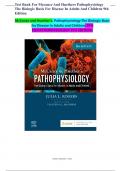Test Bank For Mccance And Huethers Pathophysiology
The Biologic Basis For Disease In Adults And Children 9th
Edition
McCance and Huether’s, Pathophysiology:The Biologic Basis
for Disease in Adults and Children, 9TH
ED(PATHOPHYSIOLOGY 9TH EDITION)
NURSINGTB.COM
,Test Bank For Mccance And Huethers Pathophysiology
The Biologic Basis For Disease In Adults And Children 9th
Edition
Chapter 1: Cellular Biology
MULTIPLE CHOICE
1. Which statement best describes the cellular function of metabolic absorption?
a. Cells can produce proteins. c. Cells can take in and use nutrients.
b. Cells can secrete digestive enzymes. d. Cells can synthesize fats.
ANS: C
In metabolic absorption, all cells take in and use nutrients and other substances from their
surroundings. The remaining options are not inclusive in their descriptions of cellular
metabolic absorption.
PTS: 1 REF: Page 2
2. Most of a cell’s genetic information, including RNA and DNA, is contained in the:
a. Mitochondria c. Nucleolus
b. Ribosome d. Lysosome
ANS: C
The nucleus contains the nucleolus, a small dense structure composed largely of RNA,
most of the cellular DNA, and the DNA-binding proteins, such as the histones, which
regulate its activity. The other options do not contain most of a cell’s genetic information.
PTS: 1 REF: Page 2
3. Which component of the cell produces hydrogen peroxide (HNURSINGTB.COM 2O2) by
using oxygen to remove hydrogen atoms from specific substrates in an oxidative reaction?
a. Lysosomes c. Ribosomes
b. Peroxisomes d. Oxyhydrosomes
NURSINGTB.COM
,Test Bank For Mccance And Huethers Pathophysiology
The Biologic Basis For Disease In Adults And Children 9th
Edition
ANS: B
Peroxisomes are so named because they usually contain enzymes that use oxygen to
remove hydrogen atoms from specific substrates in an oxidative reaction that produces
H2O2, which is a powerful oxidant and potentially destructive if it accumulates or escapes
from peroxisomes. Ribosomes are RNA-protein complexes (nucleoproteins) that are
synthesized in the nucleolus and secreted into the cytoplasm through pores in the nuclear
envelope called nuclear pore complexes. Lysosomes are saclike structures that originate
from the Golgi complex and contain more than 40 digestive enzymes called hydrolases,
which catalyze bonds in proteins, lipids, nucleic acids, and carbohydrates. Oxyhydrosomes
are involved in enzyme production.
PTS: 1 REF: Page 8
4. Which cell component is capable of cellular autodigestion when it is released during cell
injury?
a. Ribosome c. Smooth endoplasmic reticulum
b. Golgi complex d. Lysosomes
ANS: D
The lysosomal membrane acts as a protective shield between the powerful digestive
enzymes within the lysosome and the cytoplasm, preventing their leakage into the
cytoplasmic matrix. Disruption of the membrane by various treatments or cellular injury
leads to a release of the lysosomal enzymes, which can then react with their specific
substrates, causing cellular self-digestion. The other options do not correctly describe this
process.
PTS: 1 REF: Pages 7-8
5. What is the sequence of steps in the development of a digestive enzyme by the pancreas
cells from the initial transcription to the release from the cell?
a. The enzyme is transcribed from DNA by RNA in the nucleus, proceeds to the
ribosome for synthesis, and is transported in a secretory vesicle to the cell membrane.
b. The enzyme is transcribed from RNA by DNA in the nucleus, proceeds to the
lysosome for synthesis, and is transported in an encapsulated membrane to the cell
membrane.
c. The enzyme is transcribed by the mitochondria in the nucleus, proceeds to the
ribosome for synthesis, and is transported in a cytoskeleton to the cell membrane.
d. The enzyme is transcribed from DNA by RNA in the nucleus, proceeds to the
Golgi complex for synthesis, and is transported in a cytosol to the cell membrane.
NURSINGTB.COM
, Test Bank For Mccance And Huethers Pathophysiology
The Biologic Basis For Disease In Adults And Children 9th
Edition
ANS: A
The enzyme is transcribed from DNA by RNA in the nucleus, proceeds to the ribosome for
synthesis, and is transported in a secretory vesicle to the cell membrane. The other options
do not correctly describe this process.
NURSINGTB.COM
PTS: 1 REF: Page 7 | Figure 1-5
6. During which phase of the cell cycle is DNA synthesized?
a. G1 c. G2
b. S d. M
ANS: B
The four designated phases of the cell cycle are: (1) the G1 phase (G = gap), which is the
period between the M phase (M = mitosis) and the start of DNA synthesis; (2) the S phase
(S = synthesis), during which DNA is synthesized in the cell nucleus; (3) the G2 phase,
during which RNA and protein synthesis occurs, the period between the completion of
DNA synthesis and the next phase (M); and (4) the M phase, which includes nuclear and
cytoplasmic division.
PTS: 1 REF: Page 37
7. What organic compound facilitates transportation across cell membranes by acting as
receptors, transport channels for electrolytes, and enzymes to drive active pumps?
a. Lipids c. Proteins
b. Proteases d. Carbohydrates
ANS: C
Proteins act as (1) recognition and binding units (receptors) for substances moving in and
out of the cell; (2) pores or transport channels for various electrically charged particles
called ions or electrolytes and specific carriers for amino acids and monosaccharides; and
(3) specific enzymes that drive active pumps that promote the concentration of certain
ions, particularly potassium (K+), within the cell while keeping concentrations of other
ions, for example, sodium (Na+), below the concentrations found in the extracellular
environment. The other options do not correctly describe this process.
PTS: 1 REF: Page 13 | Page 15
8. Understanding the various steps of proteolytic cascades, such as caspase-mediated apoptosis
and complement cascades, may be useful in designing drug therapy for which human
diseases?
NURSINGTB.COM




